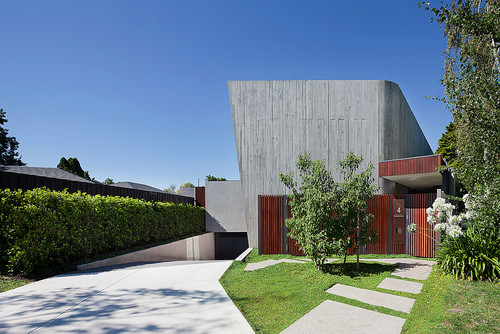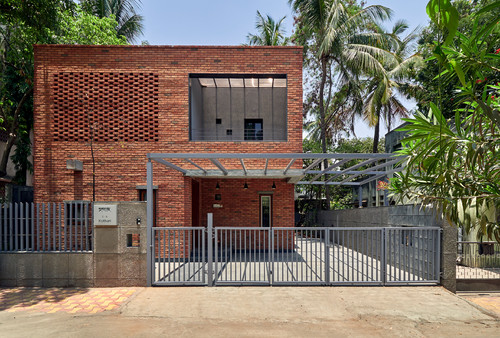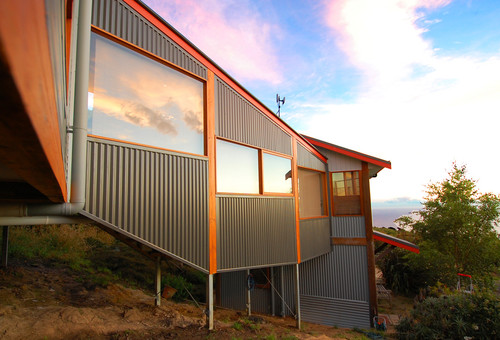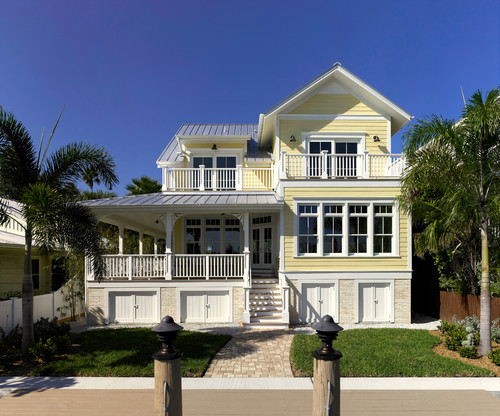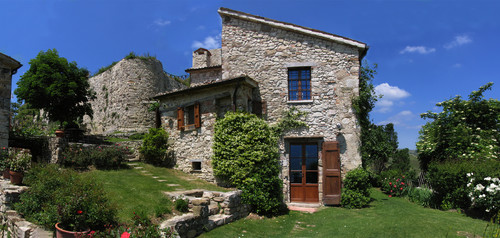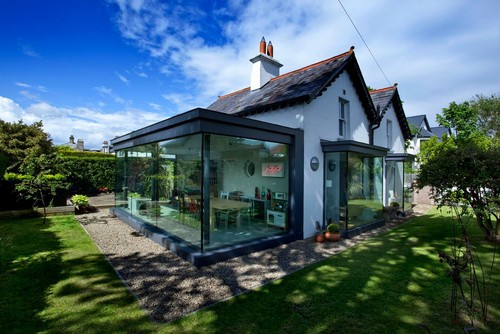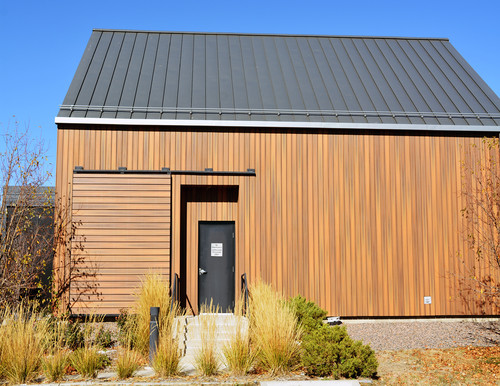The elevation or facade is an important element to consider while designing a structure, as it provides a distinct appeal to the shell of the building. The design and the subsequent material usage can reflect upon the taste, architectural style and aesthetical appeal of a structure. One can say that elevations are like trailers for an epic movie! There are ample material options available to designers today to design home elevations. Apart from design requirements, various factors determine the material palette selection. Some factors that can influence the choice of material are the availability of material, local context, budgetary considerations, climatic considerations, maintenance, and so on. One can use various materials to impart a distinct character and charm to the designed elevation. However, the following is a list of "Top 8 Home Elevation Materials Architects Must Know" while designing an impressive home elevation –
1. Raw Concrete- Bold and Versatile Facade Material
Concrete is a durable facade material that is usually used to cast the structural members of a structure. However, after the brutalist architecture styles, raw concrete was used to create elevations for buildings, which is a popular practice even now. Concrete, in its varied forms, is a popular choice for designers and homeowners to create interesting accents in their modern home exteriors and interior accents. The advantage of concrete is that it is highly durable and versatile and goes well with most materials (wood, glass, steel, etc.). Concrete and, more so, raw concrete are preferred materials by many contemporary designers.
An interesting product of choice in this cadre is fibre cement boards that can be easily clad on the external or internal surface.
2. Bricks- Timeless Elevation Material
Bricks are a timeless choice of rustic elevation material that has been popular for building impressive home facades. Laurie Baker was a pioneer who designed remarkable elevations in brick with various experimentations in laying patterns. These days, with parametric design in the picture, designers create incredible brick facade designs. Exposed clay brick elevations have an elegance and a charm like no other material. These are easy to maintain and highly durable. Moreover, the material complements an array of styles and contexts. One can opt for faux brick tiles in scenarios where exposing the brick is out of the question. This is and will remain a popular choice for constructing home elevations owing to its warm and rustic feel to a structure.
3. Metal- Sleek and Modern Facade Material
Various metals have graduated to be a popular choice of materials for not only commercial elevations but residential elevations as well. Metals such as treated steel, zinc, aluminium, copper, brass, corten steel, etc., are paving their path into home elevation design trends. The metals used in various forms – sheets or plates, beads, etc. can impart a sophisticated look to the modern facade design. With the industrial intervention, metal cladding is made available in a palette of colours and finishes (mirror, gloss, matte, textured, etc.) too.
People have started opting for metals as they are durable, fire-resistant, sleek, low maintenance and strong. Moreover, with time, metals such as copper, brass, zinc, and corten steel develop a beautiful patina owing to oxidation and weathering processes. The patina developed over a period adds charm and exclusivity to the elevation.
4. Tiles- Vibrant Facade Design
Tiles, with the advantage of availability across varied colours, patterns, shapes, and sizes, can be one of the most popular materials for residential facades. The benefit of ceramic tiles for exteriors is that they require the least maintenance and offer high durability. This is a material that has the potential to produce exceptional home elevation designs. Tiles present ample variations with which to experiment to achieve the desired aesthetics. With 3D tiles and digital printing on tiles, the possibilities are rather endless, one can produce the envisioned. This is a material that an architect or a designer working with elevations cannot do without in contemporary times.
5. Paint- Affordable Painted Facade Ideas
Paint is one of the most popular materials used in exterior home design. The paint can be applied in desired combinations and finishes on the plastered walls to create the desired look for a home elevation. The key is choosing a good quality paint produced for exterior use. The advantage of opting for a painted surface is that there is a myriad of options of colours and textures available in the market to create beautiful painted home elevations.
6. Stone- Elegant Facade Material
Stone has been a popular choice of natural elevation material for creating intriguing elevations throughout history and into modern times. The material not only adds aesthetical appeal to the structure but is also eco-friendly. This material is apt for versatility with design language and style. One can achieve an array of finishes from unpolished to highly dressed. Some commonly used stones are granite, sandstone, travertine and marble. Stone is a material that cannot be left in the material vocabulary of an architect as it is a natural material that can impart elegant tactile and aesthetic appeal to stone facade designs.
However, it is a wise decision to use stones in locations where it is locally available (keeping the sustainability criteria in mind) or make use of stone veneers.
7. Glass- Transparent Facade Material
Glass is the preferred material of choice for many commercial structures, but with the innovations in glass technologies, it has carved a niche in residential elevation design as well. Glass in its innovative forms, such as smart glass, can help in adopting a transparent look to the space at the same time allows an appropriate amount of light into the home. Glass elevations provide a modern and sophisticated look for residential glass facades.
8. Wood Plastic Composite (WPC)- Wooden Elevation Alternatives
While wood is a timeless natural material, it has limitations and is a limited resource. To attain the appeal of wood and yet be wise about its usage, wood plastic composites (WPCs) are an innovative alternative for wood. The composite is made using wood fibre and thermoplastics. WPC is gradually carving its niche and becoming a popular material for various construction applications. The material beautifully translates the wooden elevation designs and is rather tenacious due to its composition, providing durable and sustainable facade design options. The material helps in achieving low maintenance elevations with an extensive life span. This material complements various other materials, thus expanding the design possibilities.
The elevation of a home sets the first impression for your entire home and, to a certain extent, gives an insight into the taste of the occupants. Elevations today span from being minimalistic to extravagant. The choice of materials, to a great extent, helps in defining the character of a house. To get one started, the aforementioned are the 8 most popular materials for home elevation that every architect must know about. Over the years, façade or elevation design has developed as a niche in architecture that some architects particularly like to work on. While there are a lot of materials that one can use for home elevations, these are a few materials, according to us, that architects should have in their material vocabulary. After all, an elevation design comes to fruition with the application of the right materials in addition to a designer’s vision.
Please feel free to post your suggestions!
Discover more with our curated picks 12 Modern Building Materials Every Architect Must Know


